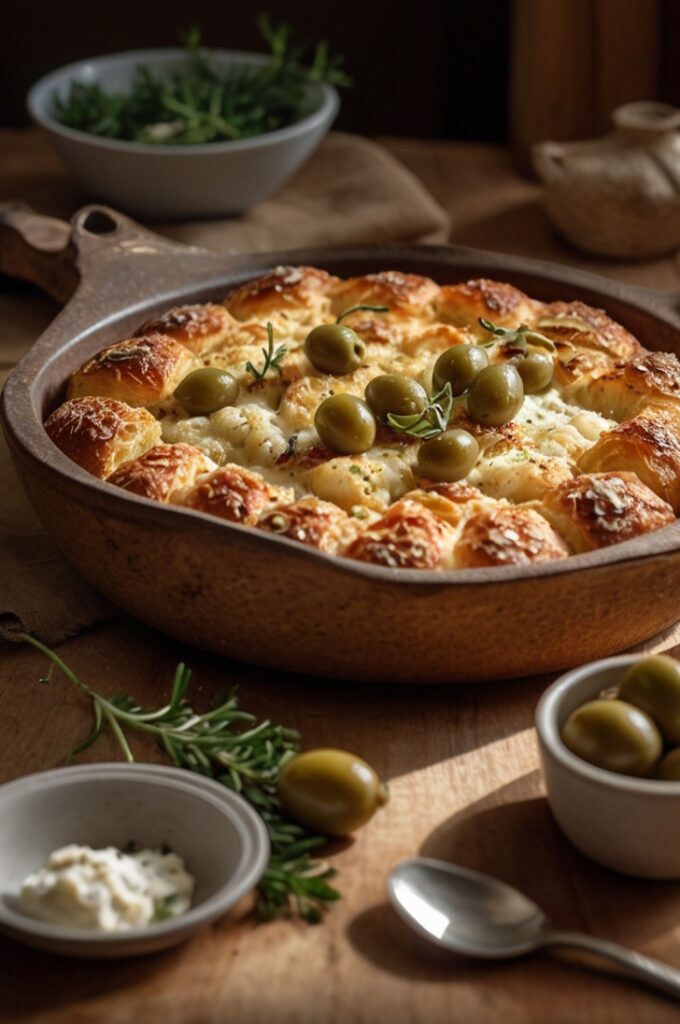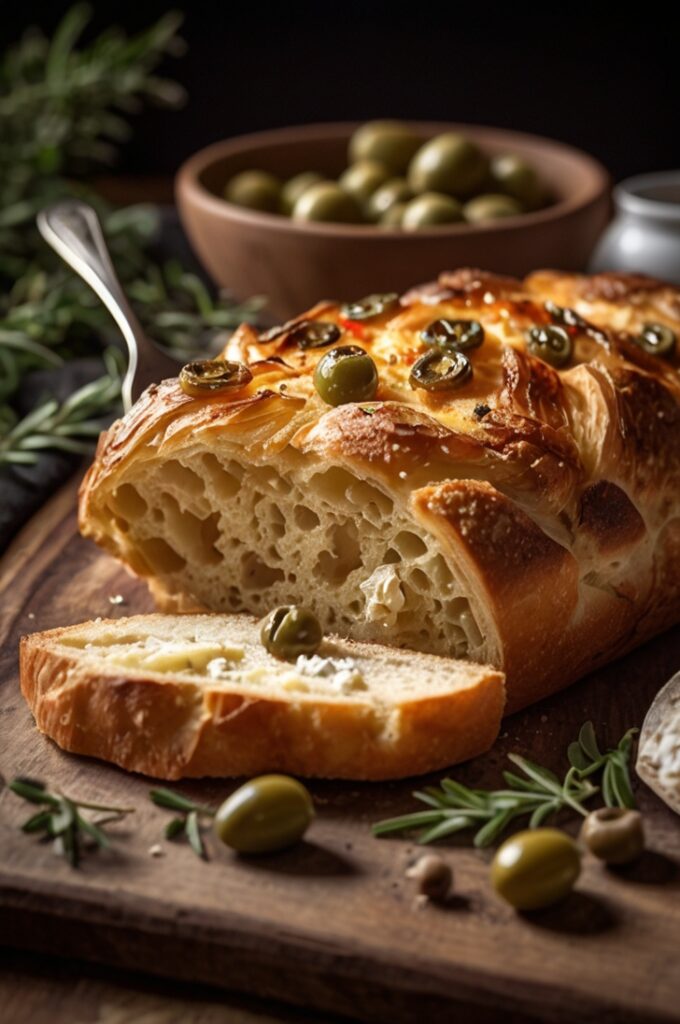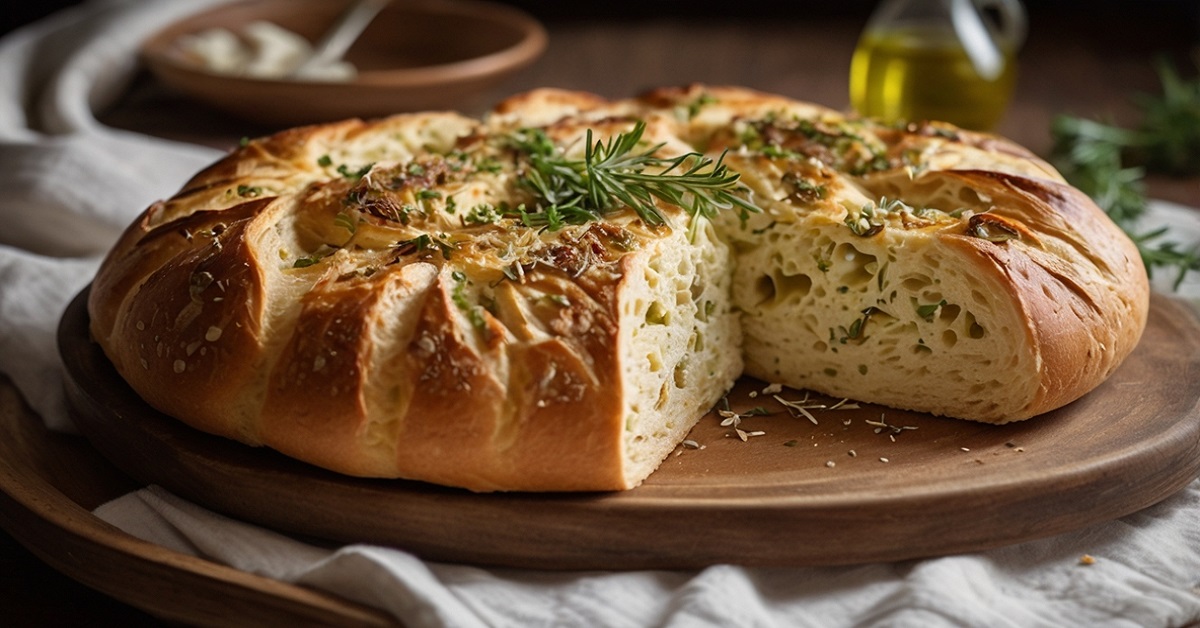I burnt my fingertips on this Mediterranean Pull A part Bread Recipe the first time I made it. Couldn’t wait. Just tore it open right on the tray bare hands, steam pouring out, garlic oil dripping through my fingers. That’s how I knew it was a keeper. You don’t wait for something like this. You just dive in.
And that’s the whole point of it messy, golden, soft and savory bread that demands to be shared, torn, and devoured while still hot.
There’s something beautifully chaotic about pull-apart bread. No knives. No slices. Just greedy hands diving in. And this Mediterranean version? It’s everything we love about the sun-drenched coasts briny olives, roasted peppers, salty feta, fresh herbs stuffed into a soft, golden loaf that you literally rip apart at the table.
It’s comfort food dressed in vacation vibes. Rustic, messy, a bit indulgent. Perfect for chefs who want flavor with drama.
This isn’t just dough and cheese. It’s technique. It’s balance. It’s learning how to coax the best textures out of a soft enriched dough while layering flavor like you’re composing music.
Let’s make it sing.
What Is Mediterranean Pull-Apart Bread?

Think of it as a savory monkey bread, but upgraded.
A yeasted dough soft, buttery is divided into small balls or squares. Each is brushed, filled, or coated with savory ingredients. Then it’s all layered into a pan, usually a bundt or loaf, and baked until golden and pillowy.
This version goes heavy on Mediterranean flavors. You get pops of feta, roasted red peppers, tapenade, fresh thyme, a whisper of lemon zest. Every bite is a different hit.
It’s ideal for sharing, which makes it excellent for catering, large family meals, or even mezze-style spreads.
And the real kicker? It holds beautifully. You can prep it ahead, freeze, bake day-of. More on that later.
Ingredients & Substitutions
Here’s what you’ll need and why each matters.
For the Dough:
- 3 ½ cups (420g) all-purpose flour
- 2 ¼ tsp (1 packet) active dry yeast
- 1 tsp sugar
- 1 tsp fine sea salt
- 1 cup (240ml) warm water (~100°F/38°C)
- ¼ cup (60ml) olive oil
- 1 egg, room temp
Substitutes & Notes:
- Swap AP flour with high-protein bread flour if you want chewier pull.
- Warm milk instead of water will yield richer dough think brioche-ish.
- No egg? A tablespoon of yogurt can sub for tenderness.
Filling & Topping:
- ⅓ cup kalamata olives, chopped
- ½ cup roasted red peppers, chopped
- ½ cup crumbled feta
- 2 tbsp sundried tomatoes, chopped
- 2 cloves garlic, minced
- 1 tbsp lemon zest
- 2 tsp fresh thyme (or ¾ tsp dried)
- 2 tbsp olive oil (for brushing)
- Flaky salt, for topping
- Optional: pinch of chili flakes or Aleppo pepper for mild heat
Substitutions & Insights:
- Goat cheese can swap in for feta slightly tangier, creamier.
- If you’re avoiding dairy altogether, try marinated artichokes and capers instead of cheese.
- Fresh herbs are ideal. Dried ones will do, but crush them between your fingers to wake ‘em up.
Don’t skip the lemon zest. That little citrus spark changes the whole profile. Adds lightness.
Step-by-Step Instructions
This recipe isn’t hard, but there are places you can mess it up if you rush. Don’t rush. Trust the process. It’s bread.
1. Make the Dough
In a large bowl, mix warm water, sugar, and yeast. Let it sit 5–10 mins. It should foam. If it doesn’t, your yeast is probably dead. Toss and start over.
Add flour, salt, olive oil, and the egg. Mix with a spoon until a shaggy dough forms. Knead on a lightly floured surface 8–10 mins, until smooth and elastic.
Professional Tip: The dough should be tacky but not sticky. Too dry and it won’t rise properly. Too wet and it’ll stick to your soul.
Pop it in an oiled bowl. Cover. Let rise until doubled usually 60–90 minutes depending on room temp.
2. Prepare Fillings
While the dough rises, chop everything. Keep pieces small no bigger than a thumbnail. You want little pops in every bite, not big clumps.
Mix olives, peppers, tomatoes, garlic, herbs, lemon zest. Add a glug of olive oil. Season lightly remember, feta and olives are salty already.
3. Shape & Fill
Punch the dough down. Turn it onto a floured counter. Roll into a rectangle, about ½ inch thick.
Cut into 2-inch squares (or tear golf ball–sized pieces if you want rustic). Press each piece flat in your palm, spoon a bit of filling into the center, then fold and roll into a ball.
Don’t overstuff. They’ll leak.
Brush each with oil. Arrange seam-side down in a greased bundt or loaf pan. Scatter extra filling over the top if you’ve got it.
Cover. Let rise again 30 mins or so until puffy and almost doubled.
4. Bake
Preheat oven to 375°F (190°C).
Bake 30–35 mins, or until golden brown and fragrant. Tap the top it should sound hollow-ish.
Brush with more olive oil while still hot. Sprinkle flaky salt, maybe a dusting of sumac or za’atar if you’re feeling it.
Let cool slightly before tearing in. Just enough that it doesn’t melt your fingerprints off.
Cooking Techniques & Science
Here’s where it gets chewy.
Why Enriched Dough?
The egg and olive oil add fat, which softens gluten development. So you get tenderness without chewiness. That’s what makes this tearable instead of crusty.
Why Layered Balls?
This method increases surface area. More edges = more golden crust = more flavor. Also creates natural pull points. It’s bread with built-in drama.
Yeast Timing:
Slower rise = better flavor. If you’ve got time, refrigerate the dough overnight. Cold fermentation adds depth. Like sourdough-lite.
Baking Vessel:
A bundt pan gives those beautiful pull-apart ridges. But a loaf pan works fine. Even a cake tin, honestly. Just don’t use a sheet tray it needs walls to climb.
Don’t skip the second rise.
It’s tempting. But that final proof is what makes it light and tender. Otherwise you get dense balls that feel like punishment.
Serving & Pairing Suggestions
This is party bread. It’s best served warm, right outta the oven, on a big wooden board with little ramekins of olive oil, balsamic, or even whipped feta.
Garnish with fresh herbs parsley, thyme sprigs, basil chiffonade if you’ve got some flair in ya.
Pair it with:
- Grilled lamb skewers or kofta
- Roasted eggplant dip (baba ghanoush)
- Crisp white wines like Assyrtiko or Pinot Grigio
- Dry rosé if you’re feeling cute
It’s also a killer brunch side. Throw some poached eggs on top and pretend it’s fancy.
Why This Recipe Works

It’s balance.
Fatty and salty from cheese and olives. Sweetness from the peppers. Bright acid from the lemon zest. Soft bread inside. Golden crust outside.
It’s structured enough to scale up for catering, yet rustic enough to keep soul.
And you can tweak it endlessly. Add caramelized onions. Sub in pesto. Fold in spinach or chard. Hell, make it spicy and call it fusion. It holds up.
The dough’s forgiving. The flavors are loud. The result? A loaf with swagger.
FAQs About Mediterranean Pull A part Bread Recipe
1. Can I make Mediterranean pull-apart bread ahead of time?
Yes. Assemble the shaped dough in the pan, cover tightly, and refrigerate overnight. Let come to room temp and proof slightly before baking.
2. Can I freeze the bread after baking?
Absolutely. Cool completely, wrap tightly, freeze up to 2 months. Reheat wrapped in foil at 325°F until warmed through.
3. What’s the best pan to use for this?
A 10–12 cup bundt pan is ideal. You get golden crust on all sides. But a standard loaf pan or 9-inch round also works.
4. Can I make it vegan?
Yes. Use plant milk, skip the egg (or sub with non-dairy yogurt), and replace feta with vegan cheese or marinated tofu.
5. My dough didn’t rise well what happened?
Check your yeast age and water temp. Anything over 115°F can kill yeast. Also, cold kitchens = slow rise. Give it time or find a warmer spot.
This bread is a showstopper. It looks complicated. But once you get your hands in it literally it just flows. Try it once, and you’ll probably end up making it three times that week.
Just… maybe let it cool a minute before you tear in. Trust me on that one.
Final Tips from the Pros
- For a crispier bottom, sprinkle semolina or cornmeal in the pan before layering dough balls.
- Want ultra-rich dough? Add 2 tablespoons Greek yogurt to the mix.
- Store leftovers wrapped in foil. Reheat at 300°F for 10–12 mins.
- Freezer tip: Shape the dough balls, freeze them on a tray. Once frozen, transfer to a bag. Bake from frozen just add 10–15 mins to bake time.




